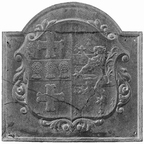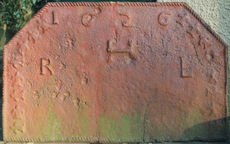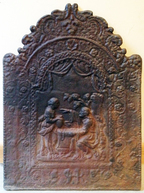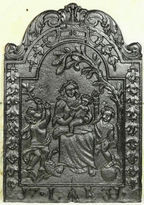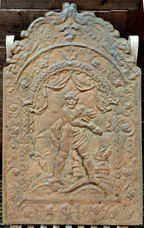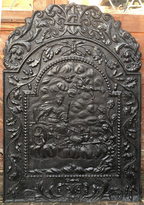-
904
Description: Arched rectangular shaped central panel with five-bead and open pellet edging; pictorial: regal figure in his chariot drawn by two horses, a sceptre in his right hand; above, a putto descends from swagged curtains and a pair of tassels; below is a landscape with a cornucopia; arched rectangular shaped border with fillet edging, a scallop shell top centre with symmetrical arrangement of ivy and acanthus leaves and tendrils; the initial, N, in a cartouche bottom centre, between symmetrical oak fronds, leaves and acorns; above is a symmetrical design of scrolled floral tendrils terminating in sea monsters.
Notes: Very similar in design and execution to firebacks of the SHR and EB series, suggesting designs emanating from the same source and with a similar inspiration. The figure in the chariot may be an allegory of the Sun. Apollo is traditionally drawn by horses.
Copies of this fireback are known.
Inscription: N
- Decoration tags:
- 'Dutch' (shape)
- fillet (edging)
- whole carved pattern
- allegorical
- animals
- humans
- plants
- objects
Manufactured: in the early-18th century in England.
Current location: not known.
- Attached to series:
- N series
- British 'Dutch' style firebacks
-
905
Description: Canted rectangle; fillet edging (top and sides); date to full width across centre of plate.
Notes: Bold, evenly-spaced numerals.
Inscription: 1680
- Decoration tags:
- rectangular with canted top corners (shape)
- fillet (edging)
- individual numbers
- text
Manufactured: in 1680 in England.
Current location: in private hands, Vauxhall, London, England.
- Attached to series:
- Date only firebacks
- 1680s Canted series
-
253
Description: Arched rectangular shape; cavetto moulded edging; garter enclosing Stuart royal arms, with supporters, crown and motto; date split either side of garter buckle; rectangular extension panel at bottom.
Notes: An altered casting from a 1641 original (no. 445), the last part of the date having disproportionate numerals; often copied. From the detail of the relief, probably an early casting.
Copies of this fireback are known.
Inscription: C R / HONI SOIT QVI MAL Y PENSE / 16 64 / DIEV ET MON DROIT
Arms: English Stuart royal
- Decoration tags:
- rectangular with round arch (shape)
- cavetto (edging)
- whole carved pattern
- individual numbers
- extension panels
- armorial
- royal
- text
Manufactured: in 1664 possibly in the Weald area of England.
Current location: not known.
- Attached to series:
- Carolean royal armorial firebacks
- Stuart royal armorial firebacks
- Royalist series
-
1054
Description: Arched rectangular shape; chamfered edging; 'renaissance' style shield with floriate decoration; incised heraldic design.
Notes: The arms are of Sir John Herbert Vernon Bt. impaling those of his wife, Elizabeth Bagnall; Blazon: (Vernon) Or, on a fess azure between two crosses moline gules three garbs of the field, a canton of a baronet; (Bagnall) Ermine, two bars or, over all a lion rampant azure. The fireback dates from between 1919, when Sir John inherited the baronetcy and his death in 1933.
Arms: Vernon impaling Bagnall
- Decoration tags:
- rectangular with round arch (shape)
- chamfered (edging)
- whole carved pattern
- heraldic
- armorial
Manufactured: in the early-20th century in England.
Current location: not known.
- Attached to series:
- Personal armorial firebacks
-
956
Description: Canted rectangle; twisted rope edging; date along the top; initials in triad across the middle; fleur-de-lys stamp repeated eight times down each side, pointing to the side or up in the order (from the top): side (2), then alternately, up first.
Notes: The initials probably represent those of a married couple, the 'H' for their surname; it is unusual for twisted rope edging to continue along the bottom of the plate.
Inscription: 1626 / RHL
- Decoration tags:
- rectangular with canted top corners (shape)
- rope (edging)
- carved stamps
- individual letters
- individual numbers
- heraldic
- text
Manufactured: in 1626 in the Forest of Dean area of England.
Current location: not known.
- Attached to series:
- Date & initials firebacks
- 1620s Dean series
-
982
Description: Arched rectangular shape with demi-bullnose edging (top and sides); 'AD' curved in arch, with straight date below; central letter 'H' in the form of a horse's bit, with initials 'F' and 'J' respectively above and below; two lengths of rope with tasselled ends looped and tied symmetrically around the 'H' and on each side.
Notes: A finely moulded personal fireback with an equestrian connection.
Inscription: AD / 1909 / HFJ
- Decoration tags:
- rectangular with round arch (shape)
- demi-bullnose (edging)
- whole carved pattern
- monogram
- text
- objects
Manufactured: in 1909 in England.
Current location: not known.
- Attached to series:
- Personal firebacks
- Date & initials firebacks
-
1220
Description: Arched rectangular shaped central panel with hollow bead edging; to the right, a seated male figure beside a wellhead, pointing towards a standing female resting a ewer on the wellhead over which a rope hangs, and behind the male figure is a tree, and above, swagged drapery; arched rectangular shaped border with fillet edging; swirled flowers and tendrils symmetrically arranged, with SHR monogram at centre bottom; two mirrored stylised sea serpents on top; to each side a vertical extension with bead edging, of the same decoration as the side borders.
Notes: The frame of the central panel and the enclosing border are identical to those noted on another fireback displaying a figure of Pluto (see fireback no. 164), while the pictorial scene, of Jesus and the Woman of Samaria (St John 4: 5-28) is more typical of continental firebacks and stoveplates. This may be an example of an image from one casting being superimposed within the frame of an earlier fireback. The central image is sharper than the surrounding border.
Inscription: SHR
- Decoration tags:
- 'Dutch' (shape)
- bead (edging)
- whole carved pattern
- extension panels
- pictorial
- biblical
- monogram
- text
Manufactured: in the late-17th to early-18th century in England.
Current location: not known.
- Attached to series:
- British 'Dutch' style firebacks
-
1017
Description: Arched rectangular central panel with fillet edging; central seated female with an infant in her arms, a swan at her feet and a standing child on each side, the one to her left facing the front and holding aloft a flaming heart, its foot on a ball; the child to her right facing the woman, holding aloft a branch in its left hand, all on a ground with an overhanging tree to the right; arched rectangular border with fillet edging with descending festoons of acanthus flowers on each side, the date and initials at the bottom and, at the top on each side, a pair of acanthus flowers descending from a heart-shaped terminal of a strapwork frame; above, mirrored swirls of foliage.
Notes: The central pictorial scene is a crude pastiche of a panel portraying an allegory of Charity frequently used on firebacks produced in the Siegerland of north-west Germany for the Dutch market in the second half of the seventeenth century. The swirled foliage on the top is typical of English 'Dutch' style firebacks of the early-eighteenth century and the numerals are also more typically English in style.
Inscription: 17 . IAK[?] 31
- Decoration tags:
- 'Dutch' (shape)
- fillet (edging)
- whole carved pattern
- individual letters
- individual numbers
- allegorical
- text
- humans
- plants
Manufactured: in 1731 in England.
Current location: not known.
- Attached to series:
- Charity firebacks
- British 'Dutch' style firebacks
-
164
Description: Arched rectangular shaped central panel with hollow bead edging; draped male figure standing on undulating ground with two small trees, holding a bar, flaming furnaces behind, drapery suspended from above; Arched rectangular shaped border with fillet edging; swirled flowers and tendrils symmetrically arranged, with monogram at centre bottom; symmetrical arrangement of foliage on top.
Notes: The figure is of Pluto, one of a set of 'Eight Deities' engraved by Hendrick Goltzius (1592), after Polidoro da Caravaggio; a recasting, there is a larger (420mm x 640mm) but more corroded version in Hastings Museum. The faint initials SHR are probably those of the pattern-maker. The image is of a copy; original castings are fractionally larger.
Copies of this fireback are known.
Inscription: SHR
- Decoration tags:
- 'Dutch' (shape)
- fillet (edging)
- whole carved pattern
- mythological
- monogram
- humans
Manufactured: in the late-17th to early-18th century in England.
Current location: not known.
- Attached to series:
- SHR series
- British 'Dutch' style firebacks
- Eight Deities series
-
1059
Description: Arched rectangular central panel with bead on broad fillet edging; pictorial scene of a figure in a chariot on left, drawn across clouds by two peacocks; above, a putto and a bird flying in clouds; to the right, a tree; arched rectangular border with fillet edging; symmetrical undulating oak fronds descending from a loop; at the bottom, the letter W in a cartouche between swirled foliage; on top, mirrored swirled foliage descending from a loop.
Notes: The figure is likely to be that of Hera/Juno, who is traditionally associated with peacocks. The initial 'W' probably identifies the pattern maker; a single vertical line right of centre indicates the join between two boards that formed the pattern. The 'W' initial probably denotes the pattern maker.
Inscription: W
- Decoration tags:
- 'Dutch' (shape)
- fillet (edging)
- whole carved pattern
- planklines
- pictorial
- allegorical
- text
- humans
- plants
- objects
Manufactured: in the late-17th to early-18th century in England.
Current location: not known.
- Attached to series:
- British 'Dutch' style firebacks
- W series



